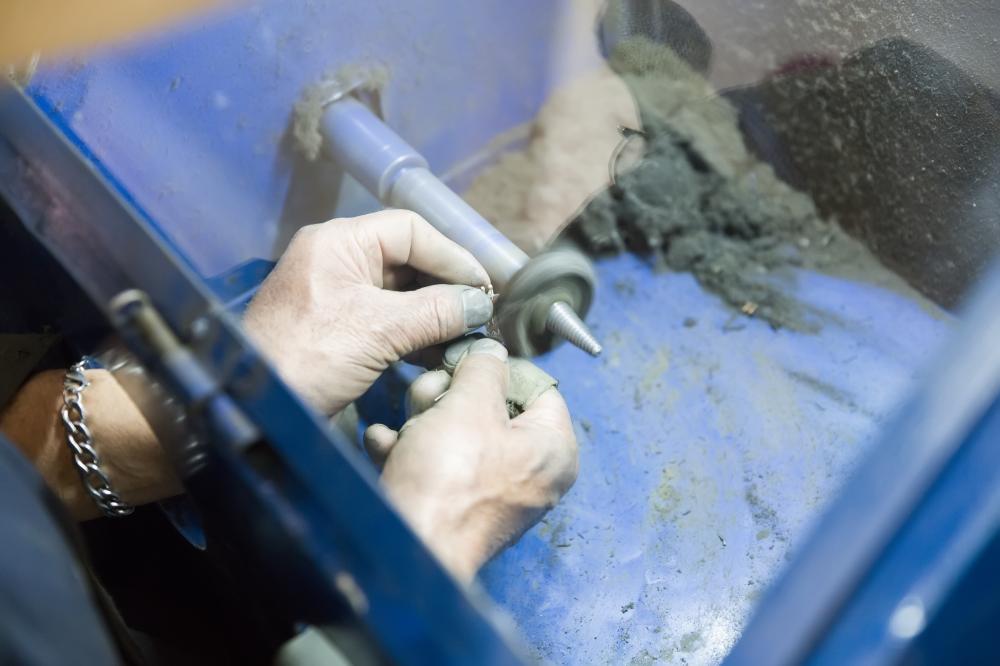
What is Green Sand Casting?
Green sand casting is a time-honored technique leveraged by manufacturers to create a myriad of parts ranging from the simplest to the most complex shapes. At its core, this process involves using sand, combined with water and clay, to form molds into which molten metal is poured. The term “green” refers not to the color of the sand but to its wet, moisture-rich state, akin to the freshness of green wood. This method is especially valued for its flexibility, scalability, and cost-effectiveness, making it an indispensable part of our manufacturing repertoire here at Protocast Inc.
One striking advantage of green sand casting is its sheer versatility. It accommodates a wide array of metals and alloys, making it an ideal choice for diverse industries from aerospace to agricultural machinery. It’s this adaptability, coupled with our commitment to quality, that positions us a mile above other foundries.
Advantages of Green Sand Casting
Cost Efficiency
The affordability of green sand casting is a significant boon. The materials used in the mold – sand, clay, and water – are readily available and inexpensive. This cost advantage allows us to pass savings onto our customers without compromising on the quality or integrity of the cast parts.
Speed and Flexibility
Speed is another hallmark of the green sand casting process. The ability to quickly form molds and adapt them to different shapes and sizes enables us to meet tight deadlines and cater to urgent demands seamlessly. This agility is particularly beneficial for projects requiring a rapid transition from design to production.
Scalability
The process’s scalability is essential for addressing various production volumes, from small batches to large-scale runs. This flexibility ensures that we can support projects of any size, affirming our role as a versatile partner to our clients.
The Process of Green Sand Casting
Our green sand casting process begins with the creation of a sand mold, which is a blend of silica sand, clay, and water. The meticulous preparation of the mold is crucial, as it directly influences the quality of the final cast component. The mold is formed around a pattern – a replica of the final part – and then split apart to remove the pattern, leaving behind a cavity in the shape of the desired part.
Molten metal is then carefully poured into this cavity. Once the metal solidifies, the mold is broken away to reveal the cast part. Despite the apparent simplicity of this process, our expertise and attention to detail are what ensure the production of parts with the requisite precision and quality.
Challenges and Solutions in Green Sand Casting
Managing Defects
One of the inherent challenges of green sand casting is the potential for defects, such as sand inclusions or gas porosity, which can compromise the integrity of the cast part. At Protocast Inc., we employ stringent quality control measures and leverage advanced technology to minimize these risks, ensuring that our castings meet the high standards our clients expect.
Achieving Precision
While green sand casting is not traditionally known for producing parts with extremely tight tolerances, our state-of-the-art equipment and skilled technicians enable us to achieve higher levels of precision than typically expected from this process. This capability allows us to serve industries with stringent requirements, such as aerospace and medical devices.
Environmental Considerations
Sustainability is a pressing concern in manufacturing, and green sand casting aligns well with eco-friendly practices. The main components of the mold are natural and non-toxic, contributing to a lower environmental footprint. Moreover, sand from broken molds can often be recycled and reused in new molds, further reducing waste.
At Protocast Inc., we actively explore ways to enhance the sustainability of our operations. By investing in efficient technologies and recycling initiatives, we strive to minimize our impact on the environment while still delivering high-quality castings to our clients.
Custom Solutions for Unique Needs
No two projects are the same, and at Protocast Inc., we understand the importance of tailoring our green sand casting services to meet the specific requirements of each client. Whether it’s selecting the appropriate metal alloy, designing complex geometries, or optimizing the mold for cost-effectiveness, our team collaborates closely with clients to craft the perfect solution for their unique needs.
Our commitment to partnership extends beyond the foundry floor. We provide comprehensive support throughout the project lifecycle, from initial consultation and design to post-casting finishes and treatments. This holistic approach ensures that every client receives not just a part, but a solution that precisely fits their application.
Why Choose Protocast Inc. for Green Sand Casting
Choosing Protocast Inc. for green sand casting means partnering with a foundry that stands a mile above the rest. Our combination of cutting-edge technology, extensive industry experience, and unwavering commitment to quality sets us apart. We’re not just a supplier; we’re a partner, dedicated to helping our clients achieve their manufacturing goals with efficiency, quality, and precision.
Our ISO 9001:2015 certification and ITAR registration exemplify our dedication to maintaining the highest standards in everything we do. For clients across aerospace, automotive, medical, and consumer products industries, Protocast Inc. represents a reliable, innovative, and eco-conscious choice for all their green sand casting needs.

What is green sand in the casting process?
Green sand in casting refers to the wet mixture of sand, clay, and water used to form molds into which molten metal is poured. It’s termed “green” not because of its color, but due to its moisture content, which is reminiscent of green wood’s dampness. This mixture is prized in the casting world for its versatility, allowing for the creation of intricate parts without sacrificing cost-effectiveness. Imagine sculpting your dream sandcastle, but instead of seawater and sand, we’re using this specially blended green sand to cast components that might end up in everything from your car to surgical equipment. It’s that blend of practicality and potential that makes green sand casting a cornerstone of our operations here.
Is green sand good for casting?
Absolutely! Green sand casting is an incredible process for several reasons. Its affordability is a major plus, allowing us to keep costs down while maintaining high standards for quality and durability. It’s also incredibly adaptable–whether you’re working with aluminum, iron, or other alloys, green sand molds can be shaped to meet a wide variety of needs. Combine this with the fact that the sand can often be reused, and you’ve got a method that’s not only efficient and flexible but also kinder to the environment than many alternatives. When clients come to us with a challenging component shape or a tight production timeline, green sand casting often provides the perfect solution.
How do you make green sand for casting?
Creating green sand for casting is akin to following a well-honed recipe. We start with high-quality silica sand, which offers the ideal combination of thermal stability and durability. To this, we add bentonite clay as a binder to hold the sand grains together, and then mix in water to give the sand its “green” or moldable quality. The precise proportions can vary depending on the specific requirements of the casting, such as the type of metal being cast and the desired surface finish. The magic of this process is in the balance–too much water and the sand won’t hold its shape; too little, and the mold could crack. It’s a craft that requires not just knowledge but a touch of intuition, honed through years of experience.
What is the difference between green and dry sand casting?
While both methods involve sand as the primary material for creating molds, the key difference lies in the binder technology and moisture content. Green sand casting uses a mixture of sand, clay, and water, making it adaptable and relatively inexpensive. Dry sand casting, on the other hand, involves using a chemical binder instead of water, which is added to the sand before the mold is created. This method is often used for larger castings or when higher precision is required, as it can provide greater mold strength and thermal stability. However, dry sand casting typically involves more complex processes and higher costs, making green sand casting a preferred choice for a wide range of applications, particularly those where flexibility and cost are critical considerations.
How do you manage defects in green sand casting?
Managing defects in green practice involves a combination of skilled craftsmanship, rigorous quality control, and continuous improvement. We start by ensuring our green sand is of the highest quality, with the correct mixture of sand, clay, and water for the job at hand. Our technicians are trained to spot potential issues early in the process, from improper mold compaction to issues with the molten metal. We also leverage advanced technologies, from simulation software to real-time monitoring equipment, to predict and prevent defects before they occur. Despite the inherent challenges of any casting process, our commitment to excellence means we are constantly refining our techniques, learning from each project, and implementing best practices that help minimize defects and exceed our clients’ expectations.
What are the environmental benefits of green sand casting?
The environmental benefits of green sand casting are significant and align well with our commitment to sustainable manufacturing practices. Firstly, the main components of green sand molds are natural and non-toxic, minimizing the ecological footprint of our casting operations. Furthermore, the ability to reclaim and recycle sand from used molds is a game-changer, drastically reducing waste and conserving resources. By focusing on efficiency and recycling, we’re not just creating high-quality castings; we’re also contributing to a more sustainable future for manufacturing. It’s a win-win for both our clients and the planet, showcasing that high-quality manufacturing and environmental responsibility can go hand in hand.
Resources
- American Foundry Society (AFS) – The American Foundry Society provides valuable resources and information on the foundry industry, including green sand casting.
- National Renewable Energy Laboratory (NREL) – NREL offers insights into sustainable manufacturing practices, including environmental considerations in casting processes.
- ASM International – ASM International is a leading materials information society, providing expertise on various metal alloys used in green sand casting.
- The Guardian Environment – The Guardian’s Environment section covers news and articles on environmental sustainability, relevant to green sand casting.


